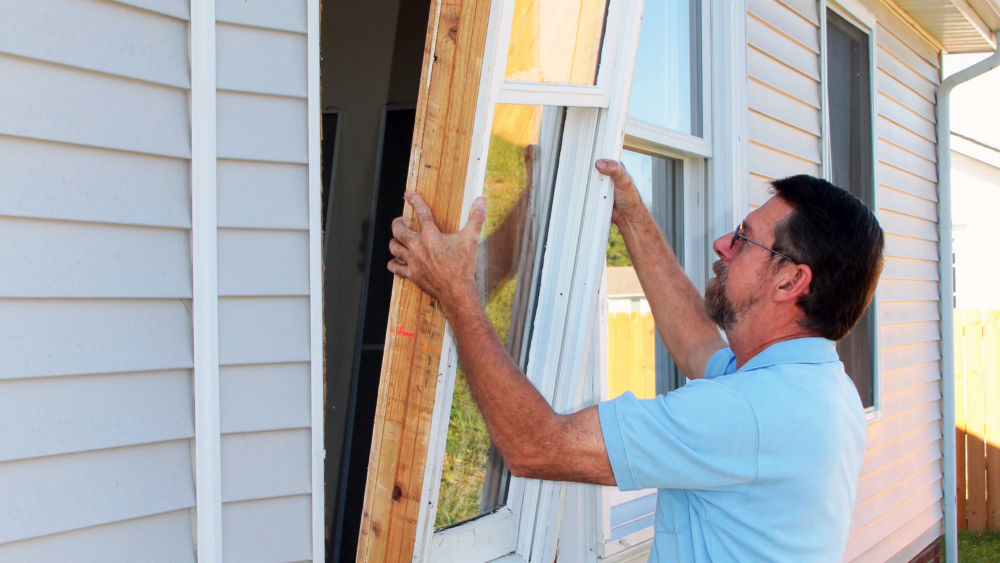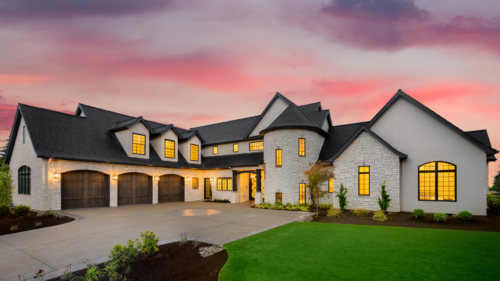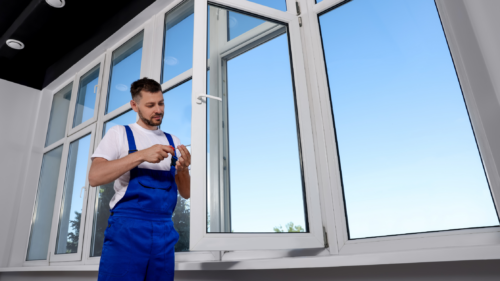Ever gazed through your old, drafty windows on a frosty morning and wondered how much heat — and cash — is escaping? Or perhaps you’ve pondered the cost of those chic modern replacements you spotted online?
You’re not alone.
Finding funding for window replacement can feel like peering into a foggy glass labyrinth. But what if I told you that the foggy glass labyrinth doesn’t have to be so daunting? That there’s light at the end of this twisty maze?
Intrigued yet? Good!
This post will guide you through government grants, private financing options, and other resources available to homeowners just like yourself. You’ll discover different types of window replacements, their costs and long-term savings potentials. And yes, we’ll even tackle choosing a reputable company to do the job right.
Are you prepared to gain a deeper understanding of funding?
Understanding the Need for Window Replacement
Many homeowners overlook the importance of their windows. But, they play a significant role in your home’s energy efficiency and overall appeal. Replacing old or inefficient windows can make a world of difference.
Aesthetics Matter
Your house should reflect your personal style. And yes, that includes your windows. Over time, styles change and so do our tastes. Swapping out outdated window designs with modern ones can dramatically improve the look of your home. Here are some popular types to consider.
Better Energy Efficiency
We’re all looking for ways to save on energy bills right? High-quality replacement windows could be an answer you need. They help keep heat inside during winter and outside during summer which means lower heating & cooling costs. The Department of Energy provides more insights here.
Maintaining Your Home Value
No one likes seeing money go down the drain due to depreciated property value. Believe it or not, replacing those aging windows might just boost up that market price tag.
- Damaged frames or broken panes negatively impact curb appeal.
- Newer models have improved security features – a major selling point.
- Eco-friendly options are increasingly attractive to today’s buyers because they want sustainable homes too.
Comfort and Convenience
Let’s not forget the comfort factor. Drafty windows make for chilly winters and sweaty summers. Replacing them ensures a comfortable indoor climate all year round.
The noise from outside can be irritating too. Modern windows have better sound insulation, providing peace of quiet when you need it most. Here’s more on how they work.
All these reasons highlight why window replacement is an important aspect of home improvement. So, don’t underestimate those glass panes – they’re worth more than just a good view.
Exploring Various Types of Window Replacements
Replacing windows in a residence is not a straightforward, universal solution. Different window styles cater to different needs, aesthetics, and budgets.
Vinyl Windows
Vinyl windows are well-loved for their affordability and energy efficiency. They’re easy to maintain but offer fewer color options than other types. The Department of Energy even highlights their superior thermal performance.
Wooden Windows
If you’re looking for an old-world charm or live in a historical district, wooden windows might be your go-to choice. They insulate well but need more care to prevent rotting and warping over time.
Fiberglass Windows
Fiberglass windows come with higher upfront costs but make up for it with stellar durability and insulation properties. According to the International Association of Certified Home Inspectors (InterNACHI), fiberglass material can significantly reduce energy consumption.
Aluminum Windows
In coastal areas where wind resistance is crucial, aluminum wins hands down. These strong frames withstand harsh weather conditions better than most others; however, they may not perform as well on the insulation front as some alternatives do.
With so many factors at play when selecting replacement windows – from initial cost through maintenance demands and lifespan expectations – it’s vital that homeowners weigh all pros & cons before making this important decision.
Remember: What works best for one home may not be the best fit for another. So, don’t rush. Take your time to understand each option and pick what suits your needs perfectly.
Initial Costs of Window Replacement
However, understanding the initial costs can help you budget effectively.
Labor Costs
The labor involved in window replacement usually accounts for about 50% of the total cost. According to HomeAdvisor, homeowners typically spend between $150 and $800 per window on labor alone. This range depends largely on the complexity of installation and local rates.
Material Costs
In addition to labor, material costs play a crucial role too. Depending upon your choice – whether vinyl, wood or aluminum – prices may vary significantly. Vinyl tends to be more affordable with an average price tag around $200-$700 per window while wooden frames could set you back anywhere from $600 up to even $1,000 each as stated by Modernize Home Services Guide.
Potential Hidden Expenses
Beware. There are potential hidden expenses that can surprise unwary homeowners like disposal fees or unexpected structural repairs needed once old windows get removed.
To avoid these surprises during your project it’s wise to ask contractors upfront about all possible additional charges not included in their original quote.
Remember: knowledge is power when tackling any major home improvement projects like this one so doing some research beforehand can really pay off.
Long-Term Benefits and Savings from Window Replacement
The long-term financial benefits of window replacement are often overlooked, but they’re worth considering. Replacing windows with energy-efficient models can result in up to 15-20% savings on heating and cooling costs. That’s like getting a discount on your energy bills every month.
If you think about it, it’s like planting a tree that saves you money instead of giving shade. And these savings aren’t just for one or two years; high-quality windows can last for decades with proper care.
Reduced Energy Bills
Say goodbye to drafty rooms. Modern windows provide better insulation than their older counterparts. This means less heat escapes in winter and less cool air leaks out during summer.
Your HVAC system won’t have to work as hard to keep your home comfortable, leading to lower energy consumption. The Department of Energy estimates this could save homeowners between $126-$465 annually.
Increase in Home Value
Beyond the utility bill savings, replacing old windows improves curb appeal – an essential factor when selling a house. It’s estimated that homeowners recoup around 70% of the project cost upon resale.
Akin to adding a fresh coat of paint or upgrading fixtures, new windows enhance aesthetic appeal. Potential buyers are more likely to pay a premium for homes with recent upgrades, including window replacements.
Comfort and Peace of Mind
New windows offer benefits beyond the financial aspect. They improve comfort by reducing drafts and noise from outside. Plus, they require less maintenance than older models – giving you one less thing to worry about.
So while the initial investment might seem steep, remember that replacing your windows is an investment in comfort, energy efficiency, and home value.
Government Grants for Window Replacement
The cost of window replacement can be a hurdle for many homeowners. But, the good news is that government grants exist to help with these expenses. These grants aim to encourage energy efficiency and home improvement.
The U.S Dept of Energy’s WAP provides a grant to aid low-income households in reducing their energy bills through enhancing home efficiency, including replacing windows. This program helps low-income families reduce their energy costs by improving home energy use, including window replacements.
Another option might be your local city or county initiatives. Many areas have programs designed to help homeowners improve their properties’ value and conserve resources. For example, The City of San Francisco offers a Home Improvement Loan Program (HILP), which provides financial assistance for various improvements, like window upgrades.
Finding Government Grants
To find out what types of funding are available in your area, start by visiting websites like Grants.gov, where you can search for federally funded opportunities related to housing repairs and renovations.
You could also contact your state’s housing department directly or reach out to local nonprofit organizations specializing in community development and housing support. They may know about specific grants suitable for your needs.
Evaluating Eligibility Requirements
Bear in mind that each grant has its own eligibility requirements – some cater specifically towards low-income households while others focus on elderly citizens or veterans. You need to carefully read through the eligibility criteria of each grant before applying.
If you are not eligible for a particular grant, there may be other options that better suit your needs.
Navigating the Application Process
The application process can sometimes seem daunting but remember – this is essentially free money towards improving your home’s efficiency and value. The key here is persistence and patience. It might take some time to gather all necessary documents, fill out forms correctly, or wait for approval. But the potential savings make it worthwhile.
Private Funding Options for Window Replacement
Funding window replacements privately opens up a range of possibilities. Homeowners can tap into their savings, use credit cards, or even apply for home improvement loans.
Savings
Dipping into your personal stash is an immediate and interest-free option to fund your window replacement project. However, it’s important to not deplete all your reserves – remember the golden rule of keeping at least three months’ worth of expenses untouched in case of emergencies.
Credit Cards
If you have enough credit limit available, using a credit card could be an easy way to pay for new windows. But keep in mind that high-interest rates can make this option expensive if balances aren’t paid off quickly.
Home Improvement Loans
A more structured approach would be applying for a home improvement loan. These are often unsecured personal loans specifically designed for renovations like window replacements. Interest rates are generally lower than those on credit cards but higher compared to HELOCs.
- The loan amount will depend on factors such as income and credit score.
- You’ll get fixed monthly payments which help with budgeting.
- Lenders usually let borrowers repay over two to seven years depending on the borrowed amount.
Note: Be sure to compare different lenders’ terms and conditions before making any decisions.
Window replacements are an investment that can boost property value and provide energy savings in the long run, despite any initial costs. They can increase property value and provide energy savings over time. So while there might be upfront costs, the long-term benefits could very well outweigh them.
Evaluating Return on Investment (ROI) for Window Replacement
When considering window replacement, it’s important to look beyond the initial costs. We need to consider the long-term benefits as well, especially energy savings and increased home value.
The ROI calculation isn’t just about how much you spend versus what you get back immediately. It also involves understanding how these improvements can lead to significant cost reductions over time. To help with this analysis, Energy.gov provides excellent resources that give homeowners an idea of potential energy savings when replacing old windows with energy-efficient ones.
Factoring in Energy Savings
An integral part of calculating ROI is factoring in monthly utility bill reductions from improved insulation and less heat loss through your new windows. The EIA reports that households can potentially save up to 15% annually on heating and cooling bills by investing in more efficient windows, which could result in a savings of approximately $300 per year for those who previously spent an average of $2000 yearly. Energy Information Administration (EIA), households could save up 15% on their annual heating and cooling bills by switching to more efficient windows.
This means if your average yearly expenditure was $2000 before replacement, you might be looking at saving around $300 per year.
Considering Increased Home Value
Apart from reduced utility bills, another factor contributing towards a positive ROI is increased property value due after window replacements are done properly using high-quality materials. A study conducted by Remodeling Magazine’s Cost vs Value Report indicates that homeowners can recoup nearly 72% of their project cost upon selling their homes – meaning that if your window upgrade cost $10,000, you could potentially increase your home’s value by around $7,200.
But remember, ROI isn’t just about money. There are also non-monetary benefits like improved comfort and aesthetics to consider when evaluating the return on your investment.
Tips for Choosing a Window Replacement Company
When it comes to choosing a window replacement company, there are several key factors you should consider. Ensuring your investment yields quality and durability is essential.
Credentials Matter
You wouldn’t trust an unlicensed doctor with your health, so why gamble with an uncertified window installer? Look for companies certified by organizations like NARI, which indicates they’ve met industry standards. Make sure their team has proper training and experience too.
Check Out Reviews
Online reviews can give you insight into a company’s reliability and customer service. Check out platforms such as Yelp or Google Reviews to see what previous customers have said about their experiences.
Inquire About Warranties
A reputable company stands behind its work with warranties on both products and labor. Before making any decisions, ask each potential provider about their warranty offerings – this can save you from unexpected costs down the line.
Pricing Transparency Is Key
Beware of hidden charges. Good firms provide detailed estimates upfront without vague wording or undisclosed fees. It helps if they offer free consultations too – giving them points for transparency and commitment.
Finally, don’t forget to use comparison sites like CostGuide.com. They let homeowners compare quotes from multiple providers side-by-side — saving time while ensuring value-for-money deals.
Remember: replacing windows is a big job, but with careful research and the right questions, you can find a company that makes it feel like a breeze.
FAQs in Relation to Funding for Window Replacement
Will the government pay for my new windows?
Yes, certain government programs can help cover your window replacement costs. Just make sure you meet their eligibility requirements.
What does the Illinois Weatherization Program cover?
The program covers energy efficiency upgrades including insulation, weather stripping, and yes – window replacements too.
How can I save money on replacing windows?
To save cash on window replacements, consider energy-efficient options for long-term savings or look into grants and loans to offset initial costs.
How do you qualify for free windows in Florida?
In Florida, qualifying low-income households may get free windows through various assistance programs like weatherization aid. Make sure to check eligibility rules first.
Conclusion
Replacing your windows doesn’t have to break the bank. With a clear understanding of why and when you need window replacements, half the battle is won.
Funding for window replacement can come from various sources like government grants or private financing options. Discovering the right fit for your situation is key.
Remember, this isn’t just an expense – it’s an investment in energy efficiency and home value. So calculate that ROI wisely!
Pick your window replacement company with care because quality work pays off in the long run.
In essence, make smart choices, explore all funding avenues available to you and get ready to enjoy those new views! If you’re ready to replace your windows, check out costguide.com to get free estimates from local pros.




